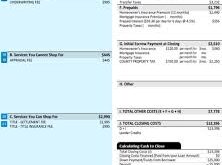Mortgage Down Payment: Learning Before Buying a Home. Buying a home is one of the most significant financial decisions in life, and one of the key factors in the process is the mortgage down payment. Understanding how much to put down, the benefits of different payment amounts, and available assistance programs can help you make an informed decision. This article provides a comprehensive guide to mortgage down payments, including tips, FAQs, and expert advice.
What Is a Mortgage Down Payment?
A mortgage down payment is the initial upfront payment made when purchasing a home. It is expressed as a percentage of the home’s total purchase price and is typically paid at closing. The remaining amount is covered by a mortgage loan, which is repaid over time.
Common Down Payment Percentages
Lenders typically require a down payment ranging from 3% to 20% of the home’s purchase price, depending on the loan type and borrower profile:
- 3% – 5%: Conventional loans (minimum requirement with Private Mortgage Insurance (PMI))
- 3.5%: FHA loans (government-backed for first-time homebuyers)
- 10% – 20%: Conventional loans without PMI
- 0%: VA and USDA loans (for eligible military personnel and rural homebuyers)
How Much Should You Put Down?
Determining the right down payment depends on your financial situation, goals, and the loan type. Here are the factors to consider:
1. Loan Qualification
A higher down payment can improve your loan eligibility by reducing the lender’s risk.
2. Monthly Mortgage Payments
A larger down payment means a lower loan amount, reducing your monthly mortgage payments.
3. Private Mortgage Insurance (PMI)
PMI is required for down payments under 20% on conventional loans. Avoiding PMI can save you hundreds of dollars monthly.
4. Interest Rate Benefits
Lenders often offer better interest rates to borrowers who put down a higher amount.
5. Emergency Savings
Ensure you have enough savings left after the down payment to cover emergencies and maintenance costs.
Down Payment Assistance Programs
If you struggle to save for a down payment, various programs can help:
1. Federal Housing Administration (FHA) Loans
- Requires as little as 3.5% down
- Available to borrowers with credit scores of 580+
2. VA Loans (Veterans Affairs)
- No down payment required
- Available to active-duty military members and veterans
3. USDA Loans (United States Department of Agriculture)
- No down payment required
- Available for eligible rural homebuyers
4. State and Local Assistance Programs
- Grants, low-interest loans, or deferred loans for first-time buyers
5. Employer Homebuyer Assistance Programs
- Some employers offer down payment assistance as a benefit
How to Save for a Mortgage Down Payment
Saving for a down payment requires discipline and planning. Here are some strategies:
1. Create a Budget
Track expenses and set realistic savings goals.
2. Open a High-Yield Savings Account
Earn interest while keeping your savings secure.
3. Cut Unnecessary Expenses
Reduce discretionary spending to increase savings.
4. Increase Your Income
Consider a side hustle, freelancing, or asking for a raise.
5. Use Windfalls Wisely
Tax refunds, bonuses, and inheritances can boost your savings.
10 Tips for a Smart Mortgage Down Payment Strategy
- Aim for a 20% down payment to avoid PMI.
- Consider loan programs with lower down payment requirements.
- Research down payment assistance programs in your state.
- Prioritize a strong credit score for better mortgage rates.
- Save early and consistently in a dedicated account.
- Work with a mortgage broker to find the best loan options.
- Compare different mortgage lenders for competitive terms.
- Avoid depleting your emergency savings for the down payment.
- Use gift funds if allowed by the lender.
- Factor in additional homeownership costs, such as property taxes and maintenance.
10 FAQs About Mortgage Down Payments
1. What is the minimum down payment for a mortgage?
It depends on the loan type. Conventional loans require as little as 3%, while FHA loans need 3.5%.
2. Can I buy a house with no down payment?
Yes, VA and USDA loans allow eligible buyers to purchase homes with no down payment.
3. How does a larger down payment affect my loan?
A higher down payment lowers your loan amount, reduces monthly payments, and may secure better interest rates.
4. Can I use a personal loan for a down payment?
Most lenders do not allow this because it increases your debt burden.
5. How can I avoid paying PMI?
By putting at least 20% down on a conventional loan.
6. Are there tax benefits to making a larger down payment?
While the down payment itself is not tax-deductible, a lower loan balance may reduce interest payments, which can be deductible.
7. Can I use my 401(k) for a down payment?
Yes, but withdrawing from a 401(k) may come with penalties and tax implications.
8. How long does it take to save for a down payment?
It varies based on income, expenses, and savings strategy. Typically, it takes several years.
9. Do down payment assistance programs have income limits?
Many programs have income restrictions to ensure they help low-to-moderate-income buyers.
10. Can I negotiate my down payment amount with a lender?
No, but you can choose a loan program that requires a lower down payment.
Conclusion
A mortgage down payment is a crucial part of homeownership, impacting your loan terms, monthly payments, and financial future. While a larger down payment offers benefits like lower interest rates and avoiding PMI, various programs make homeownership accessible even with a smaller upfront payment.
By understanding your options, utilizing available assistance, and implementing smart saving strategies, you can successfully navigate the home-buying process and secure the best mortgage deal. Whether you’re a first-time buyer or a seasoned investor, making an informed decision on your down payment will set you up for long-term financial success.
 mortgage.kbk.news
mortgage.kbk.news
